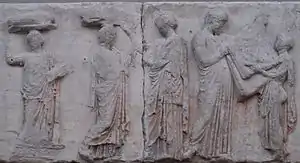
The High Priestess of Athena Polias held the highest religious office in Ancient Athens.
She enjoyed great prestige and played an official role which was otherwise uncommon in Ancient Athens. Several occasions are mentioned when she made her influence known in historical events of importance, and she is known to have influenced offices by recommendation.
She supervised the city cult of Athena based in the Parthenon, and was the chief of the lesser officials, such as the plyntrides, arrephoroi and kanephoroi.[1] She was the high priest of one of the three cults of the Acropolis of Athens: the other two were the High Priest of Poseidon-Erechtheus and the Priestess of Athena Nike.
The most known individual official of this position was Lysimache I, whose name may have inspired the character of Lysistrata in Aristophanes's play.[2] The actual Lysimche I served in the positions for 64 years in the early 4th century BCE.[3] The priesthood was an inherited and eponymous position for married women, and lasted for life.[4]
The office could not have survived the ban of all non-Christian priesthoods during the persecution of pagans in the late Roman Empire.
See also
References
- ↑ Joan Breton Connelly, Portrait of a Priestess: Women and Ritual in Ancient Greece
- ↑ Cohen, Edward (2000). The Athenian nation. Princeton NJ: Princeton University Press. p. 46-47. ISBN 9780691094908.
- ↑ Lefkowitz, Mary; Fant, Maureen (2016). Women's life in Greece and Rome : a source book in translation. Baltimore: Johns Hopkins University Press. p. 364. ISBN 0801883105.
- ↑ O'Brian, Julia (2014). The Oxford Encyclopedia of the Bible and Gender Studies. New York: Oxford. p. 174. ISBN 9780199836994. Retrieved 12 November 2023.
- Jeffrey M. Hurwit, The Athenian Acropolis: History, Mythology, and Archaeology
- Joan Breton Connelly, Portrait of a Priestess: Women and Ritual in Ancient Greece
- Garland, Robert, Religion and the Greeks, Bristol Classical Press, London, 1994